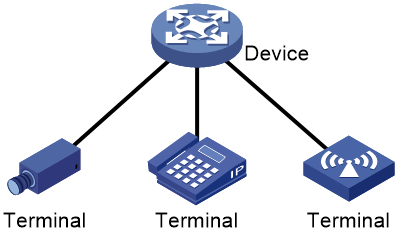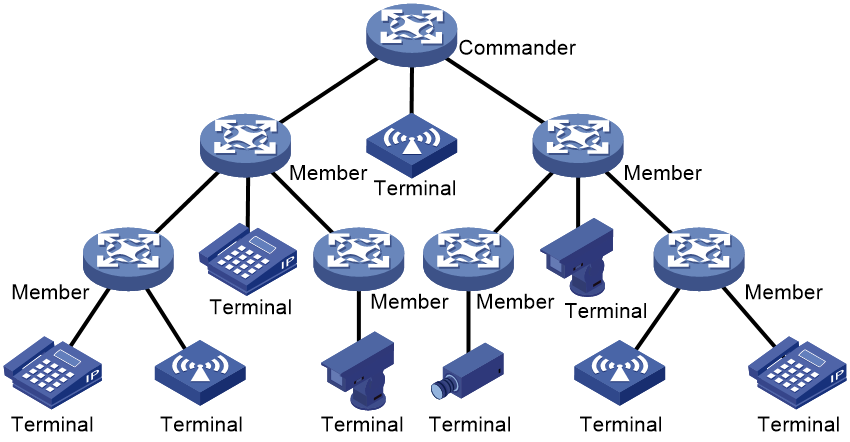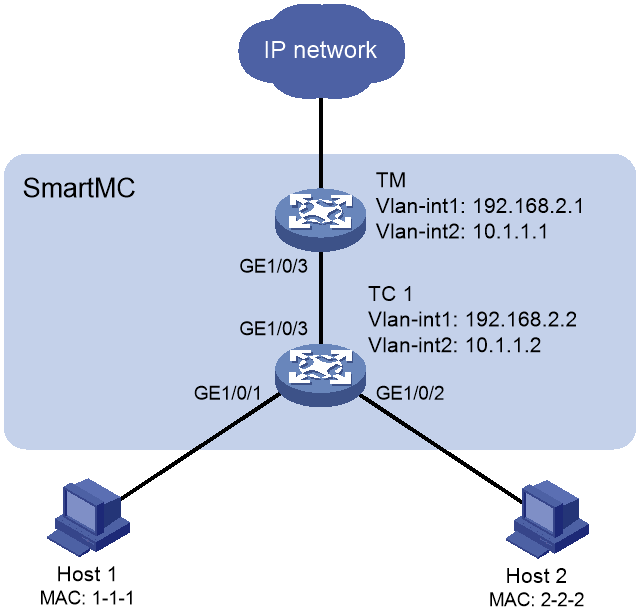- Table of Contents
-
- 11-Network Management and Monitoring Configuration Guide
- 00-Preface
- 01-System maintenance and debugging configuration
- 02-NQA configuration
- 03-iNQA configuration
- 04-NTP configuration
- 05-PTP configuration
- 06-Network synchronization configuration
- 07-PoE configuration
- 08-SNMP configuration
- 09-RMON configuration
- 10-Event MIB configuration
- 11-NETCONF configuration
- 12-Ansible configuration
- 13-Puppet configuration
- 14-Chef configuration
- 15-SmartMC configuration
- 16-EPA configuration
- 17-ONVIF configuration
- 18-CWMP configuration
- 19-EAA configuration
- 20-Process monitoring and maintenance configuration
- 21-Mirroring configuration
- 22-sFlow configuration
- 23-Information center configuration
- 24-Packet capture configuration
- 25-VCF fabric configuration
- 26-Cloud connection configuration
- 27-EPS agent configuration
- 28-eMDI configuration
- 29-SQA configuration
- Related Documents
-
| Title | Size | Download |
|---|---|---|
| 16-EPA configuration | 186.25 KB |
Endpoint identification methods
Static endpoint identification
Restrictions and guidelines: EPA configuration
Configuring static endpoint identification
Display and maintenance commands for EPA
Example: Configuring static endpoint identification
Example: Configuring automatic endpoint identification (DHCP)
Configuring EPA
About EPA
Endpoint Analysis (EPA) allows you to monitor associations and disassociations of endpoints (for example, cameras and IP phones) connecting to an H3C device.
Application scenarios
Non-SmartMC networking
As shown in Figure 1, the device configured with EPA monitors associations and disassociations of endpoints connecting to it. The device can be a standalone device or an IRF fabric. For an IRF fabric, EPA monitors endpoints connecting to all members. The collected association and disassociation information will be reported to the master device for processing.
Figure 1 Non-SmartMC networking
SmartMC networking
In a SmartMC network as shown in Figure 2, EPA settings are configured only on the commander. The members report association and disassociation information about their associated endpoints to the commander. The commander records such information about all associated endpoints in the network, and deploys EPA settings to the members.
You can view EPA information in the entire network on the commander.
Endpoint identification methods
EPA supports static endpoint identification. This method identifies associations and disassociations of endpoints by matching MAC addresses of the endpoints. This method requires manual configuration of endpoint MAC addresses on the device and is applicable to networks with a small number of endpoints. This method can only identify cameras and cannot identify the vendor and operating system of cameras.
Static endpoint identification
EPA monitors endpoint associations and disassociations by monitoring the generation and aging of MAC address entries learned by devices. A device configured with EPA can monitor only endpoints in the same subnet as the endpoint access port on the device.
For more information about MAC address entries, see Layer 2—LAN Switching Configuration Guide.
Collecting endpoint association information
If a device configured with EPA learns a new MAC address entry, it compares the MAC address and VLAN ID with the configured EPA monitor rules.
· If a match is found, the device determines that a monitored endpoint came online.
¡ In a non-SmartMC network, the device records the endpoint association event locally.
¡ In a SmartMC network, if the device is the commander, it records the endpoint association event locally. If the device is a member, it reports the event to the commander.
· If no match is found, the device determines that the endpoint is not a monitored endpoint and does not record the endpoint association event.
Collecting endpoint disassociation information
When the MAC address entry of an endpoint ages out, the device determines that the endpoint went offline.
· In a non-SmartMC network, the device records the endpoint disassociation event locally for 7 days.
· In a SmartMC network, the commander records the endpoint disassociation event for 7 days.
Synchronizing information in a SmartMC network
In a SmartMC network, endpoint monitor rules are configured on the commander and deployed to all members by the commander. The rules take effect on both the commander and members. If a member detects an association or disassociation event of a monitored endpoint, it reports the event to the commander for statistics collection and analysis.
You can view endpoint associations and disassociations that occurred in the entire network from the commander. For more information about SmartMC, see "Configuring SmartMC."
Restrictions and guidelines: EPA configuration
Do not use the mac-address dynamic command to configure dynamic MAC address entries for monitored endpoints. If you do so, the system might fail to identify endpoint association events.
When you configure EPA in a SmartMC network, follow these restrictions and guidelines:
· Make sure all devices in the network support EPA.
· You can configure endpoint monitor rules only on the commander.
· Configure the same aging time for MAC address entries on all devices in the SmartMC network. Otherwise, endpoint association and disassociation analysis on the commander might be inaccurate. For more information about MAC address entries, see Layer 2—LAN Switching Configuration Guide.
· To view endpoint association and disassociation events in a SmartMC network, execute the display epa monitor-information command on the commander instead of a member. If you execute the command on a member, the command displays only association events of endpoints connecting to the member.
Configuring static endpoint identification
Restrictions and guidelines
When you configure static endpoint identification rules, follow these restrictions and guidelines:
· To configure multiple rules to monitor an endpoint in different VLANs, make sure the specified VLAN ranges in these rules do not overlap with each other.
· As a best practice to ensure the optimal EPA performance, specify the VLANs in which an endpoint will be monitored.
· If you configure a rule to monitor an endpoint in all VLANs, make sure the endpoint will not come online from over 10 VLANs.
· You can configure a maximum of 1024 monitor rules. As a best practice to ensure the optimal EPA performance, do not configure over 512 monitor rules.
· You can specify a rule ID when creating a monitor rule. If you do not specify the ID, the system assigns the smallest available ID to the rule.
· You cannot execute the epa monitor-rule command multiple times to edit an existing rule. To edit an existing rule, use the undo epa monitor-rule command to delete the rule and then create the rule again.
Procedure
1. Enter system view.
system-view
2. Create a static endpoint identification rule.
epa monitor-rule [ monitor-rule-id ] mac mac-address [ mask mac-mask ] [ vlan vlan-id ]
By default, no static endpoint identification rules exist.
Disabling EPA logging
About this task
By default, the EPA module logs endpoint associations and disassociations. If a monitored endpoint comes online or goes offline frequently, the device will generate a large number of log entries. In this case, to avoid affecting device performance, disable EPA logging as a best practice.
Procedure
1. Enter system view.
system-view
2. Disable EPA logging.
epa online-offline-log disable
By default, EPA logging is enabled.
Display and maintenance commands for EPA
Execute display commands in any view.
|
Task |
Command |
|
Display endpoint association and disassociation information detected by EPA. |
display epa monitor-information [ online | offline ] [ device device-id | mac mac-address [ vlan vlan-id ] ] [ verbose ] |
EPA configuration examples
Example: Configuring static endpoint identification
Network configuration
As shown in Figure 3, the SmartMC network is established manually. Configure the devices in SmartMC network so EPA can automatically identify camera 1 and camera 2 when they access the SmartMC network.
Configuring the TM
1. Configure SmartMC:
# Configure VLAN-interface 1.
[TM] interface vlan-interface 1
[TM-Vlan-interface1] ip address 192.168.2.2 24
[TM-Vlan-interface1] quit
# Enable HTTP and HTTPS.
[TM] ip http enable
[TM] ip https enable
# Enable the Telnet service.
[TM] telnet server enable
# Enable NETCONF over SOAP over HTTP.
[TM] netconf soap http enable
# Enable LLDP globally.
[TM] lldp global enable
# Create a user. Set the username to admin and password to hello12345, add the telnet, http, and https service types, and authorize the user to use the network-admin user role.
[TM] local-user admin
[TM-luser-manage-admin] password simple hello12345
[TM-luser-manage-admin] service-type telnet http https
[TM-luser-manage-admin] authorization-attribute user-role network-admin
[TM-luser-manage-admin] quit
# Set scheme authentication for VTY user lines 0 to 63.
[TM] line vty 0 63
[TM-line-vty0-63] authentication-mode scheme
[TM-line-vty0-63] quit
# Enable SmartMC, set the device role to commander, and set the username to admin and the password (plaintext) to hello12345.
[TM] smartmc tm username admin password simple hello12345 enable
2. Configure static endpoint identification rules on the commander.
[TM] epa monitor-rule mac 1-1-1
[TM] epa monitor-rule mac 2-2-2
Configuring TC 1
1. Configure SmartMC:
# Configure VLAN-interface 1.
<TC1> system-view
[TC1] interface vlan-interface 1
[TC1-Vlan-interface1] ip address 192.168.2.1 24
[TC1-Vlan-interface1] quit
# Enable HTTP and HTTPS.
[TC1] ip http enable
[TC1] ip https enable
# Enable the Telnet service.
[TC1] telnet server enable
# Enable NETCONF over SOAP over HTTP.
[TC1] netconf soap http enable
# Enable LLDP globally.
[TC1] lldp global enable
# Create a user named admin.
[TC1] local-user admin
# Lower password complexity requirements. For more information about these commands, see password control commands in Security Command Reference.
[TC1-luser-manage-admin] password-control length 4
[TC1-luser-manage-admin] password-control composition type-number 1 type-length 1
[TC1-luser-manage-admin] undo password-control complexity user-name check
# Set the username and password to admin, add the telnet, http, and https service types, and authorize the user to use the network-admin user role.
[TC1-luser-manage-admin] password simple admin
[TC1-luser-manage-admin] service-type telnet http https
[TC1-luser-manage-admin] authorization-attribute user-role network-admin
[TC1-luser-manage-admin] quit
# Set scheme authentication for VTY user lines 0 to 63.
[TC1] line vty 0 63
[TC1-line-vty0-63] authentication-mode scheme
[TC1-line-vty0-63] quit
# Enable SmartMC and set the device role to member.
[TC1] smartmc tc enable
Configuring TC 3
# Configure TC 3 in the same way TC 1 is configured. (Details not shown.)
Verifying the configuration
# On TC 1, display the online and offline information of endpoints.
[TC1] display epa monitor-information verbose
Auto identification : Disabled
Local device type : SmartMC TC
Local device ID : 3acc-58e2-0100
Total endpoints identified by EPA: 1
Access device ID: 3acc-58e2-0100
MAC address : 0001-0001-0001 VLAN : 1
IP address : -
Interface : Ten-GigabitEthernet1/0/1 Status: Online
Category : Camera Vendor: -
OS : -
# On the TM, display the online and offline information of endpoints.
[TM] display epa monitor-information verbose
Auto identification : Disabled
Local device type : SmartMC TM
Local device ID : 90bc-1b85-0300
Total endpoints identified by EPA: 2
Access device ID: 3acc-58e2-0100
MAC address : 0001-0001-0001 VLAN : 1
IP address : 192.168.2.11
Interface : Ten-GigabitEthernet1/0/1 Status: Online
Category : Camera Vendor: -
OS : -
Access device ID: 3acc-58e2-0300
MAC address : 0002-0002-0002 VLAN : 1
IP address : 192.168.2.12
Interface : Ten-GigabitEthernet1/0/1 Status: Online
Category : Camera Vendor: -
OS : -
Example: Configuring automatic endpoint identification (DHCP)
Network configuration
As shown in Figure 4, the SmartMC network is established automatically. Configure the devices in SmartMC network so EPA can automatically identify host 1 and host 2 when they access the SmartMC network through DHCP.
Configuring the TM
1. Configure SmartMC:
# Configure VLAN-interface 1.
[TM] interface vlan-interface 1
[TM-Vlan-interface1] ip address 192.168.2.1 24
[TM-Vlan-interface1] quit
# Enable HTTP and HTTPS.
[TM] ip http enable
[TM] ip https enable
# Enable the Telnet service.
[TM] telnet server enable
# Enable NETCONF over SOAP over HTTP.
[TM] netconf soap http enable
# Enable LLDP globally.
[TM] lldp global enable
# Create a user. Set the username to admin and password to hello12345, add the telnet, http, and https service types, and authorize the user to use the network-admin user role.
[TM] local-user admin
[TM-luser-manage-admin] password simple hello12345
[TM-luser-manage-admin] service-type telnet http https
[TM-luser-manage-admin] authorization-attribute user-role network-admin
[TM-luser-manage-admin] quit
# Set scheme authentication for VTY user lines 0 to 63.
[TM] line vty 0 63
[TM-line-vty0-63] authentication-mode scheme
[TM-line-vty0-63] quit
# Enable SmartMC, set the device role to commander, and set the username to admin and the password (plaintext) to hello12345.
[TM] smartmc tm username admin password simple hello12345 enable
2. Configure the DHCP server:
# Configure VLAN-interface 2.
<TM> system-view
[TM] vlan 2
[TM-vlan2] quit
[TM] interface vlan-interface 2
[TM-Vlan-interface2] ip address 10.1.1.1 24
[TM-Vlan-interface2] quit
# Exclude the IP address of the DNS server from dynamic allocation.
[TM] dhcp server forbidden-ip 10.1.1.2
# Configure DHCP address pool 0 to assign IP addresses and other configuration parameters to clients on subnet 10.1.1.0/24.
[TM] dhcp server ip-pool 0
[TM-dhcp-pool-0] network 10.1.1.0 mask 255.255.255.0
[TM-dhcp-pool-0] expired day 10
[TM-dhcp-pool-0] quit
# Enable DHCP.
[RouterA] dhcp enable
3. Enable EPA automatic endpoint identification on the commander.
[TM] epa auto-identify enable
4. Configure Ten-GigabitEthernet 1/0/3.
[TM] interface ten-gigabitethernet 1/0/3
[TM-Ten-GigabitEthernet1/0/3] port link-type trunk
[TM-Ten-GigabitEthernet1/0/3] port trunk permit vlan all
Configuring TC 1
1. Configure SmartMC:
# Configure VLAN-interface 1.
<TC1> system-view
[TC1] interface vlan-interface 1
[TC1-Vlan-interface1] ip address 192.168.2.2 24
[TC1-Vlan-interface1] quit
# Enable HTTP and HTTPS.
[TC1] ip http enable
[TC1] ip https enable
# Enable the Telnet service.
[TC1] telnet server enable
# Enable NETCONF over SOAP over HTTP.
[TC1] netconf soap http enable
# Enable LLDP globally.
[TC1] lldp global enable
# Create a user named admin.
[TC1] local-user admin
# Lower password complexity requirements. For more information about these commands, see password control commands in Security Command Reference.
[TC1-luser-manage-admin] password-control length 4
[TC1-luser-manage-admin] password-control composition type-number 1 type-length 1
[TC1-luser-manage-admin] undo password-control complexity user-name check
# Set the username and password to admin, add the telnet, http, and https service types, and authorize the user to use the network-admin user role.
[TC1-luser-manage-admin] password simple admin
[TC1-luser-manage-admin] service-type telnet http https
[TC1-luser-manage-admin] authorization-attribute user-role network-admin
[TC1-luser-manage-admin] quit
# Set scheme authentication for VTY user lines 0 to 63.
[TC1] line vty 0 63
[TC1-line-vty0-63] authentication-mode scheme
[TC1-line-vty0-63] quit
# Enable SmartMC and set the device role to member.
[TC1] smartmc tc enable
2. Configure DHCP snooping:
# Enable DHCP snooping globally.
<TC1> system-view
[TC1] dhcp snooping enable
# Assign an IP address to VLAN-interface 2.
[TC1] vlan 2
[TC1-vlan2] quit
[TC1] interface vlan-interface 2
[TC1-Vlan-interface2] ip address 10.1.1.2 24
[TC1-Vlan-interface2] quit
# Assign Ten-GigabitEthernet 1/0/1 to VLAN 2, and configure it as a trusted port.
[TC1] interface ten-gigabitethernet 1/0/1
[TC1-Ten-GigabitEthernet1/0/1] port access vlan 2
[TC1-Ten-GigabitEthernet1/0/1] dhcp snooping trust
[TC1-Ten-GigabitEthernet1/0/1] quit
# Assign Ten-GigabitEthernet 1/0/2 to VLAN 2, and configure it as a trusted port.
[TC1] interface ten-gigabitethernet 1/0/2
[TC1-Ten-GigabitEthernet1/0/2] port access vlan 2
[TC1-Ten-GigabitEthernet1/0/2] dhcp snooping trust
[TC1-Ten-GigabitEthernet1/0/2] quit
3. Configure Ten-GigabitEthernet 1/0/3.
[TC1] interface ten-gigabitethernet 1/0/3
[TC1-Ten-GigabitEthernet1/0/3] port link-type trunk
[TC1-Ten-GigabitEthernet1/0/3] port trunk permit vlan all
4. Configure a BYOD endpoint identification rule:
If you use the default fingerprint information, skip this step.
# Configure a rule to identify BYOD endpoints containing DHCP Option55 fingerprint 1,121,3,6,12,15,33,43,66,67,138,150.
[TC1] byod rule dhcp-option 1,121,3,6,12,15,33,43,66,67,138,150 device-attribute
# Configure at least one piece of the following fingerprint information.
[TC1-byod-opt-1,121,3,6,12,15,33,43,66,67,138,150] device-category PC
[TC1-byod-opt-1,121,3,6,12,15,33,43,66,67,138,150] device-vendor Xerox
[TC1-byod-opt-1,121,3,6,12,15,33,43,66,67,138,150] device-os "Window Vista/7 or Server 2008 (Version 6.0)"
[TC1-byod-opt-1,121,3,6,12,15,33,43,66,67,138,150] quit
5. Configure host 1 and host 2 to obtain IP addresses through DHCP.
Verifying the configuration
# On TC 1, verify that EPA can successfully identify the hosts when they come online.
[TC1] display epa monitor-information verbose
Auto identification : Enabled
Local device type : SmartMC TC
Local device ID : 3acc-58e2-0100
Total endpoints identified by EPA: 2
Access device ID: 3acc-58e2-0100
MAC address : 0001-0001-0001 VLAN : 2
IP address : 10.1.1.3
Interface : Ten-GigabitEthernet1/0/1 Status: Online
Category : PC Vendor: Xerox
OS : Window Vista/7 or Server 2008 (Version 6.0)
Access device ID: 3acc-58e2-0100
MAC address : 0002-0002-0002 VLAN : 2
IP address : 10.1.1.4
Interface : Ten-GigabitEthernet1/0/2 Status: Online
Category : PC Vendor: Xerox
OS : Window Vista/7 or Server 2008 (Version 6.0)
# On the TM, verify that EPA can successfully identify the hosts when they come online.
[TM] display epa monitor-information verbose
Auto identification : Enabled
Local device type : SmartMC TM
Local device ID : 90bc-1b85-0300
Total endpoints identified by EPA: 2
Access device ID: 3acc-58e2-0100
MAC address : 0001-0001-0001 VLAN : 2
IP address : 10.1.1.3
Interface : Ten-GigabitEthernet1/0/1 Status: Online
Category : PC Vendor: Xerox
OS : Window Vista/7 or Server 2008 (Version 6.0)
Access device ID: 3acc-58e2-0100
MAC address : 0001-0001-0001 VLAN : 2
IP address : 10.1.1.4
Interface : Ten-GigabitEthernet1/0/2 Status: Online
Category : PC Vendor: Xerox
OS : Window Vista/7 or Server 2008 (Version 6.0)





